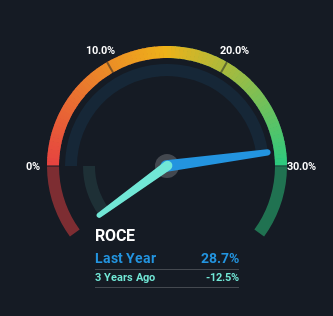- United States
- /
- Specialty Stores
- /
- NYSE:JILL
We Think J.Jill (NYSE:JILL) Might Have The DNA Of A Multi-Bagger

Finding a business that has the potential to grow substantially is not easy, but it is possible if we look at a few key financial metrics. Typically, we'll want to notice a trend of growing return on capital employed (ROCE) and alongside that, an expanding base of capital employed. If you see this, it typically means it's a company with a great business model and plenty of profitable reinvestment opportunities. With that in mind, the ROCE of J.Jill (NYSE:JILL) looks great, so lets see what the trend can tell us.
What Is Return On Capital Employed (ROCE)?
For those that aren't sure what ROCE is, it measures the amount of pre-tax profits a company can generate from the capital employed in its business. Analysts use this formula to calculate it for J.Jill:
Return on Capital Employed = Earnings Before Interest and Tax (EBIT) ÷ (Total Assets - Current Liabilities)
0.29 = US$82m ÷ (US$408m - US$124m) (Based on the trailing twelve months to April 2023).
So, J.Jill has an ROCE of 29%. That's a fantastic return and not only that, it outpaces the average of 14% earned by companies in a similar industry.
See our latest analysis for J.Jill

In the above chart we have measured J.Jill's prior ROCE against its prior performance, but the future is arguably more important. If you're interested, you can view the analysts predictions in our free report on analyst forecasts for the company.
SWOT Analysis for J.Jill
- Earnings growth over the past year exceeded the industry.
- Debt is well covered by earnings and cashflows.
- Shareholders have been diluted in the past year.
- Trading below our estimate of fair value by more than 20%.
- No apparent threats visible for JILL.
What The Trend Of ROCE Can Tell Us
You'd find it hard not to be impressed with the ROCE trend at J.Jill. We found that the returns on capital employed over the last five years have risen by 95%. That's not bad because this tells for every dollar invested (capital employed), the company is increasing the amount earned from that dollar. In regards to capital employed, J.Jill appears to been achieving more with less, since the business is using 43% less capital to run its operation. J.Jill may be selling some assets so it's worth investigating if the business has plans for future investments to increase returns further still.
For the record though, there was a noticeable increase in the company's current liabilities over the period, so we would attribute some of the ROCE growth to that. Effectively this means that suppliers or short-term creditors are now funding 30% of the business, which is more than it was five years ago. Keep an eye out for future increases because when the ratio of current liabilities to total assets gets particularly high, this can introduce some new risks for the business.
What We Can Learn From J.Jill's ROCE
In the end, J.Jill has proven it's capital allocation skills are good with those higher returns from less amount of capital. Given the stock has declined 46% in the last five years, this could be a good investment if the valuation and other metrics are also appealing. With that in mind, we believe the promising trends warrant this stock for further investigation.
J.Jill does have some risks though, and we've spotted 4 warning signs for J.Jill that you might be interested in.
If you'd like to see other companies earning high returns, check out our free list of companies earning high returns with solid balance sheets here.
New: Manage All Your Stock Portfolios in One Place
We've created the ultimate portfolio companion for stock investors, and it's free.
• Connect an unlimited number of Portfolios and see your total in one currency
• Be alerted to new Warning Signs or Risks via email or mobile
• Track the Fair Value of your stocks
Have feedback on this article? Concerned about the content? Get in touch with us directly. Alternatively, email editorial-team (at) simplywallst.com.
This article by Simply Wall St is general in nature. We provide commentary based on historical data and analyst forecasts only using an unbiased methodology and our articles are not intended to be financial advice. It does not constitute a recommendation to buy or sell any stock, and does not take account of your objectives, or your financial situation. We aim to bring you long-term focused analysis driven by fundamental data. Note that our analysis may not factor in the latest price-sensitive company announcements or qualitative material. Simply Wall St has no position in any stocks mentioned.
About NYSE:JILL
J.Jill
Operates as an omnichannel retailer for women’s apparel under the J.Jill brand in the United States.
Very undervalued with solid track record.
Market Insights
Community Narratives



